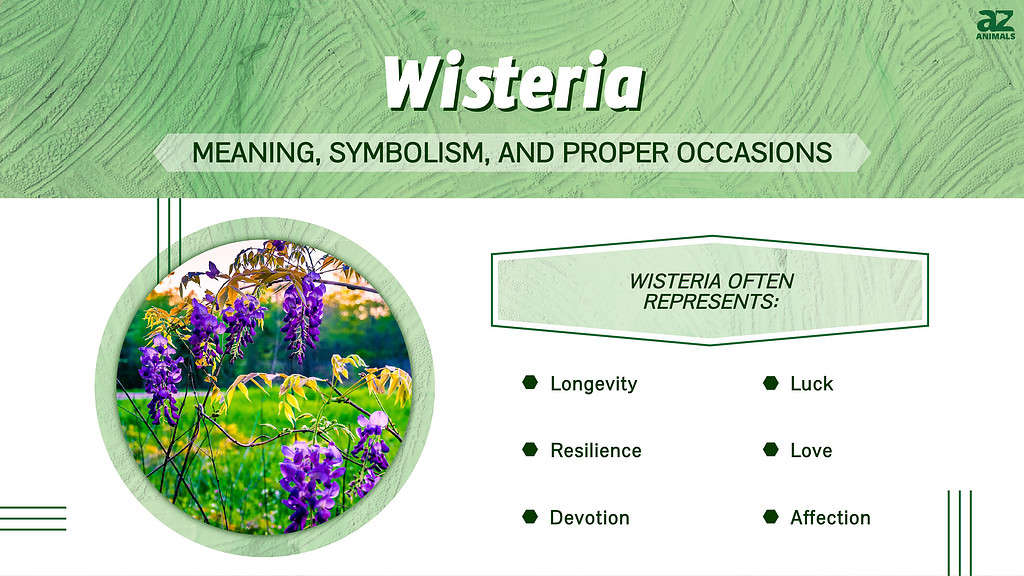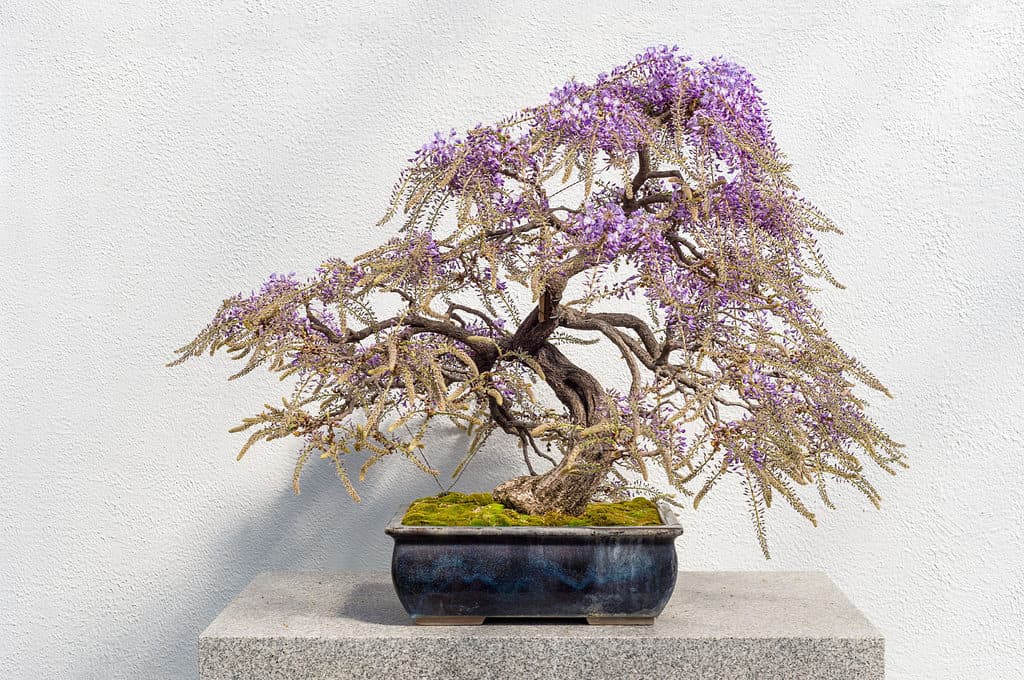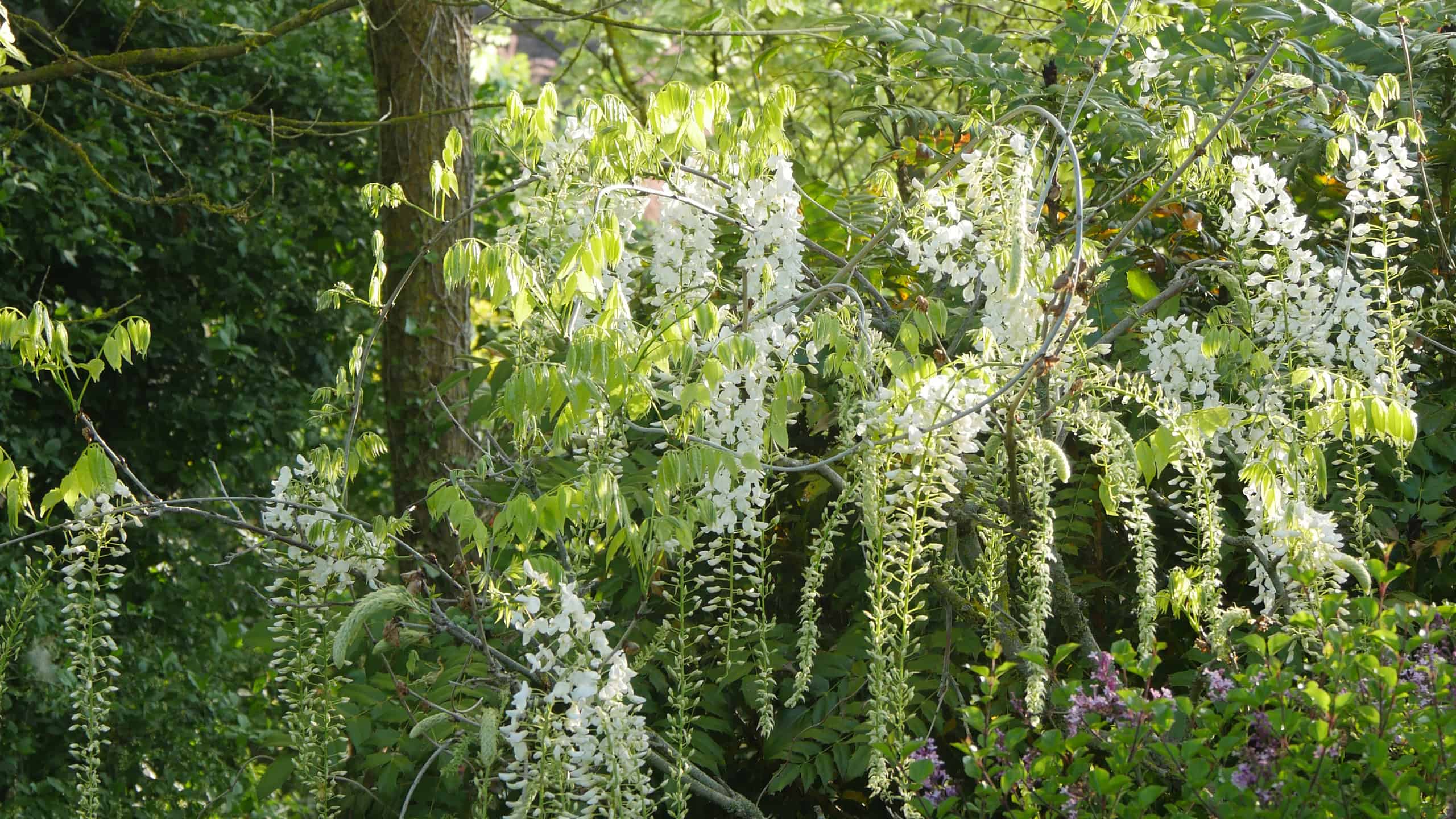Few blossoms possess the ethereal charm and grace of wisteria flowers. These blooms have captured hearts for centuries and have recently been repopularized by Netflix’s Bridgerton series. These eye-catching blooms have a fascinating history and can be as dangerous as they are beautiful. In this article, we’ll explore the meaning, symbolism, and proper occasions of wisteria flowers.
Let’s dig in!
Wisteria Flowers: The History
Wisteria flowers belong to the Wisteria genus. This plant boasts lush purple blossoms along hanging vines and tendrils cascading toward the ground.
These alluring plants are native to Asia, with Japanese Wisteria (Wisteria floribunda) and Chinese Wisteria (Wisteria sinensis) as two of the best-known species.
Wisteria flowers have a strong presence in Japanese culture and heraldry. It’s featured heavily on family crests for its rich symbolism. You can often find wisteria depicted in tile work, stained glass, and paintings.

Like many plants, wisteria is toxic to animals. Be mindful of its presence and how your pets interact with it.
©Marie A. Dolphin/Shutterstock.com
The Wisteria Maiden
One of the most famous depictions of wisteria is a dance performance called Fuji Musume (Wisteria Maiden). This tragic tale of star-crossed lovers takes place in the depths of ancient Japan. The legend of the Wisteria Maiden tells of a forbidden love that defied societal norms.
As the moon cast its silvery glow upon the land, a young woman, consumed by longing, transformed into a wisteria vine, her cascading blossoms forever whispering the tale of an eternal bond. Her sacrifice, immortalized in petals, serves as a reminder of the enduring power of love and the indomitable spirit of the human heart.
Paintings of the Wisteria Maiden were often gifted at weddings or sold as good luck charms to engaged couples in Medieval times.
The Wistaria Festival
In the charming town of Sierra Madre, California, a botanical marvel stands as a testament to nature’s astonishing resilience and beauty.
Known as the Sierra Madre Wistaria Vine, also known as simply “The Vine” or “Lavender Lady,” has earned its place in the annals of horticultural history. It’s important to note that this wisteria plant is intentionally called “Wistaria.”
With an awe-inspiring length of over one acre and a weight of over 250 tons, it holds the title of the largest blossoming plant in the world. Its sinuous branches, adorned with delicate lavender blooms, create a breathtaking spectacle that draws visitors from far and wide.
Botanical experts believe The Vine is more than 100 years old. Its remarkable vitality has allowed it to survive numerous challenges, including floods and fires. This botanical wonder serves as a living testament to the enduring spirit of nature, captivating all who encounter its ethereal beauty.
Wisteria Flowers: Meaning and Symbolism
Like many flowers, the meaning and symbolism behind wisteria depend on the color.
Wisteria symbolizes resilience and longevity, as this stunning plant can live for centuries. However, lavender or blue wisteria, as depicted in The Wisteria Maiden, can also symbolize rejection and lost love.
If you’re presenting wisteria as a gift for someone in the Japanese culture, choosing another color is essential. Purple wisteria also symbolizes royalty and undying devotion or love that transcends time.
White wisteria represents purity and new beginnings, while pink showcases friendship and love.

Wisteria Flowers: Proper Occasions
This flower is a beautiful gift for engagements and weddings. The symbolized luck and longevity bear good tidings for newlyweds. This symbolism also makes wisteria a lovely gift for milestone anniversaries.
White wisteria is a beautiful gift to welcome new babies to the world in the Western hemisphere. However, white is sometimes associated with death and funerals in Eastern cultures; it’s important to be mindful of the recipient’s beliefs.
Wisteria Flowers: Growth Tips
The most important consideration when growing wisteria is finding a native species.
Japanese wisteria (Wisteria floribunda) and Chinese wisteria (Wisteria sinensis) are incredibly invasive in North America. These stunning vines’ rapid growth and weight have destroyed buildings and ravaged local ecosystems.
Look for a native species of American wisteria (Wisteria frutescens) to experience this stunning plant without causing harm to your local environment. This species will grow in USDA zones 5-9.
Wisteria prefers full sunlight for optimal growth. While the vines will grow in the shade, they won’t produce the delicate blooms that make this plant so enchanting. Wisteria prefers well-draining soil.
Finally, give these beautiful vines ample support and structure for climbing. Plant them away from your house and provide a reinforced pergola or a metal trellis, as the vines will get heavier as time goes on.
Is Wisteria Toxic?
Wisteria is incredibly toxic to animals and people when ingested. The vines produce pods, similar in appearance to beans. Ingesting wisteria pods results in gastrointestinal distress and central nervous system damage, known as Wisteria Syndrome.
There have recently been posts online that eating wisteria is ok and won’t cause harm. It’s essential to do your research and err on the side of caution when ingesting plants.

With drooping flowers, wisteria Bonsai trees are a great way to grow this plant indoors or in a small area.
©Marc Bruxelle/Shutterstock.com
Thank you for reading! Have some feedback for us? Contact the AZ Animals editorial team.








